유투브의 최단 경로 알고리즘을 정리한 글입니다.
최단 경로 알고리즘
-
가장 짧은 경로를 찾는 알고리즘
-
다양한 문제 상황
- 한 지점에서 다른 한 지점까지의 최단 경로
- 한 지점에서 다른 모든 지점까지의 최단 경로
- 모든 지점에서 다른 모든 지점까지의 최단 경로
-
각 지점은 그래프에서 노드로 표현
-
지점 간 연결된 도로는 그래프에서 간선으로 표현
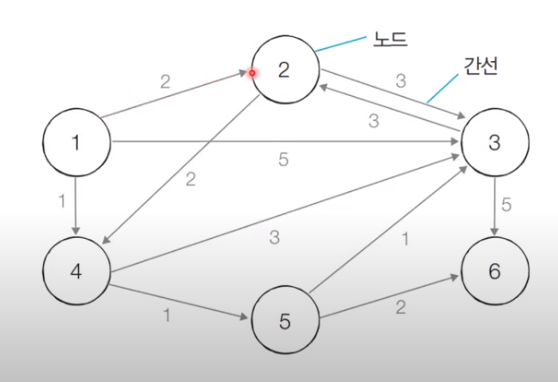
다익스트라 최단 경로 알고리즘
- 특정한 노드에서ㅓ 출발하여 다른 모든 노드로 가는 최단 경로를 계산
- 다익스트라 최단 경로 알고리즘은 음의 간선이 없을 때 정상적으로 동작
- 현실 세계의 도로는 음의 간선으로 표현되지 않음 - 다익스트라 최단 경로 알고리즘은 그리디 알고리즘으로 분류
- 매 상황에서 가장 비용이 적은 노드를 선택해 임의의 과정 반복
- 알고리즘 동작 과정
- 출발 노드를 설정
- 최단 거리 테이블을 초기화
- 방문하지 않은 노드 중에서 최단 거리가 가장 짧은 노드 선택
- 해당 노드를거쳐 다른 노드로 가는 비용을 계산해 최단 거리 테이블 갱신
- 위 과정에서 3번과 4번을 반복한다.
- 알고리즘 동작 과정에서 최단 거리 테이블은 각 노드에 대한 현재까지의 최단 거리 정보를 가짐
- 처리 과정에서 더 짧은 경로를 찾으면 '이 경로가 젤 짧은 경로야' 라고 갱신

출발 -> B ->A로 갱신
예시1
- 초기상태
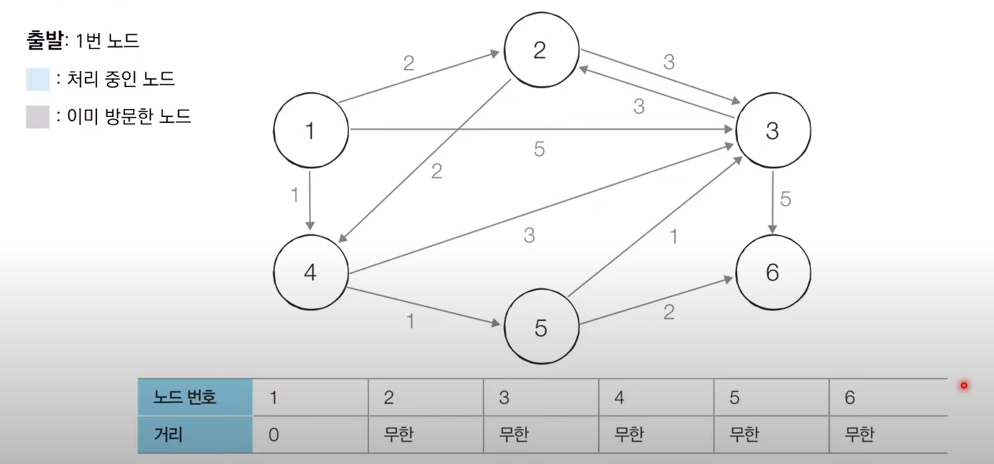
- Step 1

- Step 2
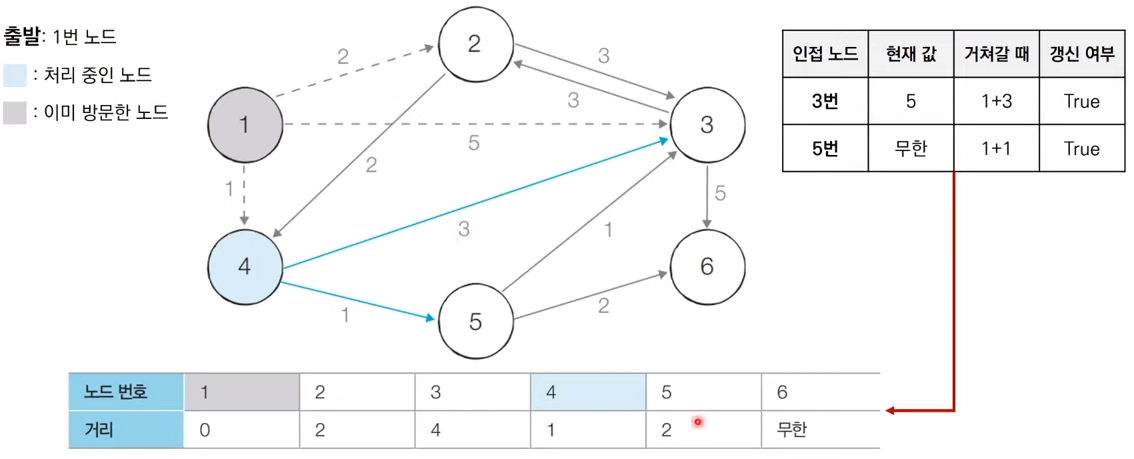
- Step 3

(방문처리 된 노드 무시해도 됨, 그림에서는 무시하지 않았음) - Step 4
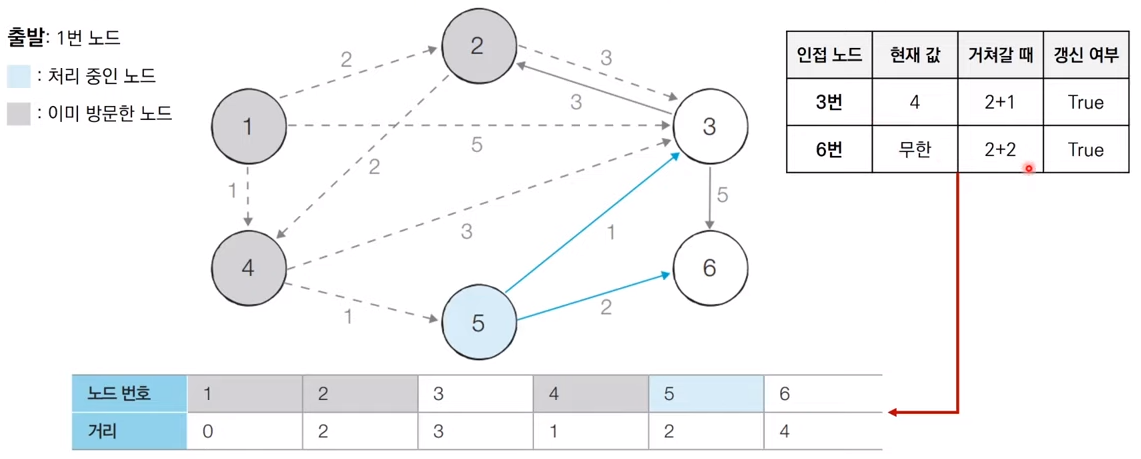
- Step 5
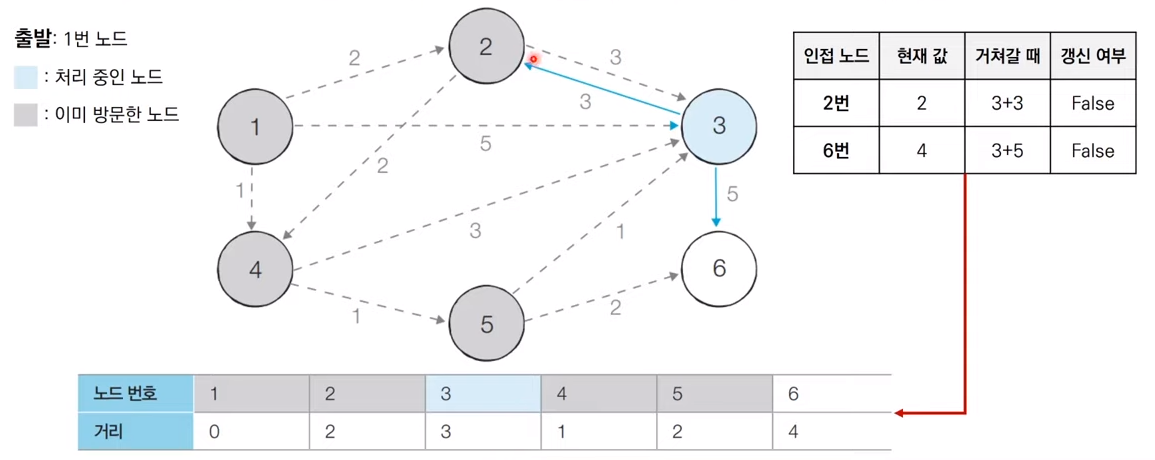
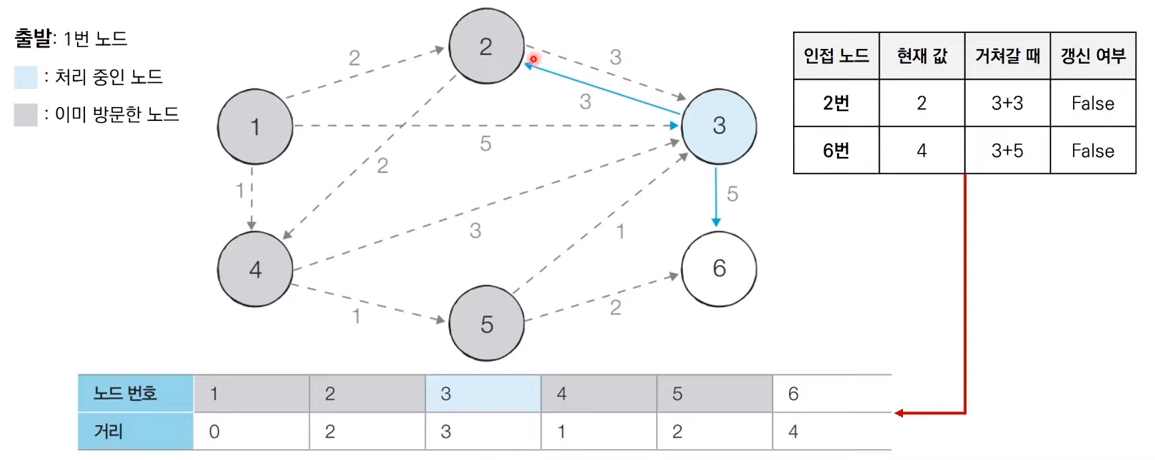
- Step 6
마지막 노드에 대해서는 계산 안해도됨
다른 노드에 대한 계산 값이 바뀌지 않기 때문

예시에서는 간선이 없어서 계산할 게 없음
다익스트라 알고리즘 특징
- 그리디 알고리즘 : 매 상황에서 방문하지 않은 가장 비용이적은 노드 선택해 임의의 과정 반복
- 단계를 거치며 한번 처리된 노드의 최단 거리는 고정되어 더 이상 바뀌지 않는다.
- 한 단계당 하나의 노드에 대한 최단거리는 확실히 찾는 것으로 이해할 수 있음 - 다익스트라 알고리즘을 수행한 뒤에 테이블에 각 노드까지의 최단 거리 정보가 저장
- 완벽한 형태이 최단 경로를 구하려면 소스코드에 추가적인 기능을 더 넣어야 함
구현1
- 단계마다 방문하지 않은 노드 중에서 최단 거리가 가장 짧은 노드를 선택하기 위해 매 단계마다 1차원 테이블의 모든 원소를 확인(순차 탐색)
import java.io.BufferedReader;
import java.io.IOException;
import java.io.InputStreamReader;
import java.util.*;
class Node{
private int index;
private int distance;
public Node(int index, int distance){
this.index = index;
this.distance= distance;
}
public int getIndex(){
return this.index;
}
public int getDistance(){
return this.distance;
}
}
public class Dijkstra {
public static final int INF = (int) 1e9; //무한을 의미하는 값, 10억 설정
//노드의 개수 n. 간선의 개수 m . 시작 노드 번호 start
//노드의 개수는 최대 100,000
public static int n,m,start;
//각 노드에 연결되어 있는 노드에 대한 정보를 담는 배열
public static ArrayList<ArrayList<Node>> graph = new ArrayList<>();
//방문한 적 있는지 체크하는 목적의 배열 만들기
public static boolean[] visited = new boolean[100001];
//최단 거리 테이블 만들기
public static int[] d = new int[100001];
//방문하지 않은 노드 중에서, 가장 최단 거리가 짧은 노드의 번호 반환
public static int getSmallestNode(){
int minV = INF;
int index = 0; //가장 최단거리가 짧은 노드(인덱스)
for(int i=1;i<=n;i++){
if(d[i]<minV && !visited[i]){
minV = d[i];
index = i;
}
}
return index;
}
public static void dijkstra(int start){
//시작 노드에 대해서 초기화
d[start] = 0;
visited[start] = true;
//거리 테이블 세팅
for(int j=0;j<graph.get(start).size();j++){
d[graph.get(start).get(j).getIndex()]= graph.get(start).get(j).getDistance();
}
//시작 노드를 제외한 전체 n-1개의 노드에 대해 반복
for(int i=0; i<n;i++){
//현재 최단 거리가 가장 짧은 노드를 꺼내서, 방문 처리
int now = getSmallestNode();
visited[now] = true;
//현재 노드와 연결된 다른 노드를 확인
for(int j=0;j<graph.get(now).size(); j++){
int cost = d[now] + graph.get(now).get(j).getDistance();
//현재 노드를 거쳐서 다른 노드로 이동하는 거리가 더 짧은경우
if(cost<d[graph.get(now).get(j).getIndex()]){
d[graph.get(now).get(j).getIndex()] = cost;
//더 짧은 거리로 갱신해줌
}
}
}
}
public static void solution() throws IOException{
BufferedReader bf = new BufferedReader(new InputStreamReader(System.in));
StringTokenizer st = new StringTokenizer(bf.readLine());
int n = Integer.parseInt(st.nextToken());
int m = Integer.parseInt(st.nextToken());
int start = Integer.parseInt(st.nextToken());
///그래프 초기화
for(int i=0;i<=n;i++){
graph.add(new ArrayList<Node>());
}
//모든 간선 정보 입력 받기
for(int i=0;i<m;i++){
st = new StringTokenizer(bf.readLine());
int a = Integer.parseInt(st.nextToken());
int b= Integer.parseInt(st.nextToken());
int c = Integer.parseInt(st.nextToken());
// a번 노드에서 b번 노드로 가는 비용이 c
graph.get(a).add((new Node(b,c)));
}
//최단 거리 테이블을 모두 무한으로 초기화
Arrays.fill(d, INF);
//다익스트라 알고리즘 수행
dijkstra(start);
//모든 노드로 가기 위한 최단 거리 출력
for(int i=1;i<n;i++){
//도달할 수 없는 경우
if(d[i]==INF){
System.out.println(INF);
}
//도달할 수 있는 경우 거리 출력
else{
System.out.println(d[i]);
}
}
}
}
성능 분석
- 총 O(V)번에 걸쳐서 최단거리가 가장 짧은 노드를 매번 선형 탐색
- 따라서 전체 시간 복잡도는 O(V^2)
- 일반적으로 코딩 테스트의 최단 경로 문제에서 전체 노드 개수가 5000개 이하라면 이 코드로 문제 해결 가능
- 노드의 개수가 10,000개를 넘어가는 문제라면?
-> 우선순위 큐 사용
예시 2
우선순위 큐(힙)을 사용

-
단계마다 방문하지 않은 노드 중에서 최단 거리가 가장 짧은 노드를 선택하기 위해 힙 자료구조 이용
-
다익스트라 알고리즘이 동작하는 기본 원리는 동일
- 현재 가장 가까운 노드를 저장해놓기 위해 힙 자료구조 추가 이용
- 현재의 최단 거리ㅏㄱ 가장 짧은 노드를 선택해야 하므로 최소 힙 사용
-
초기상태
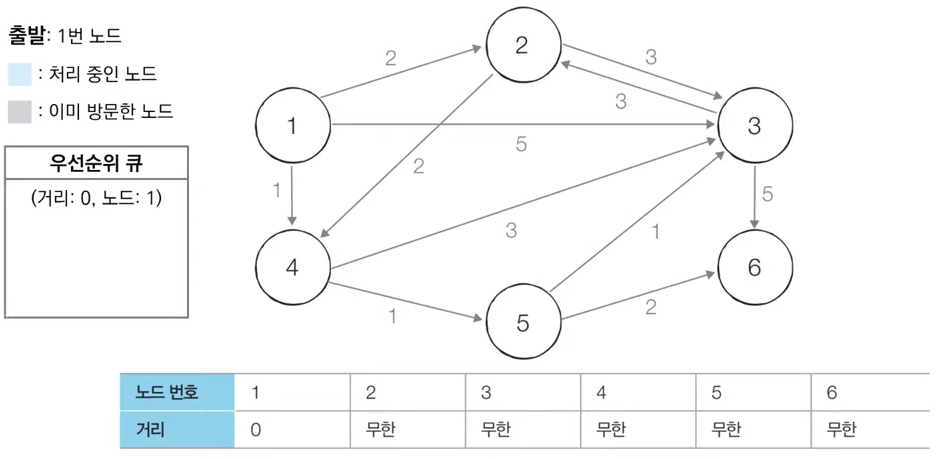
-
Step 1
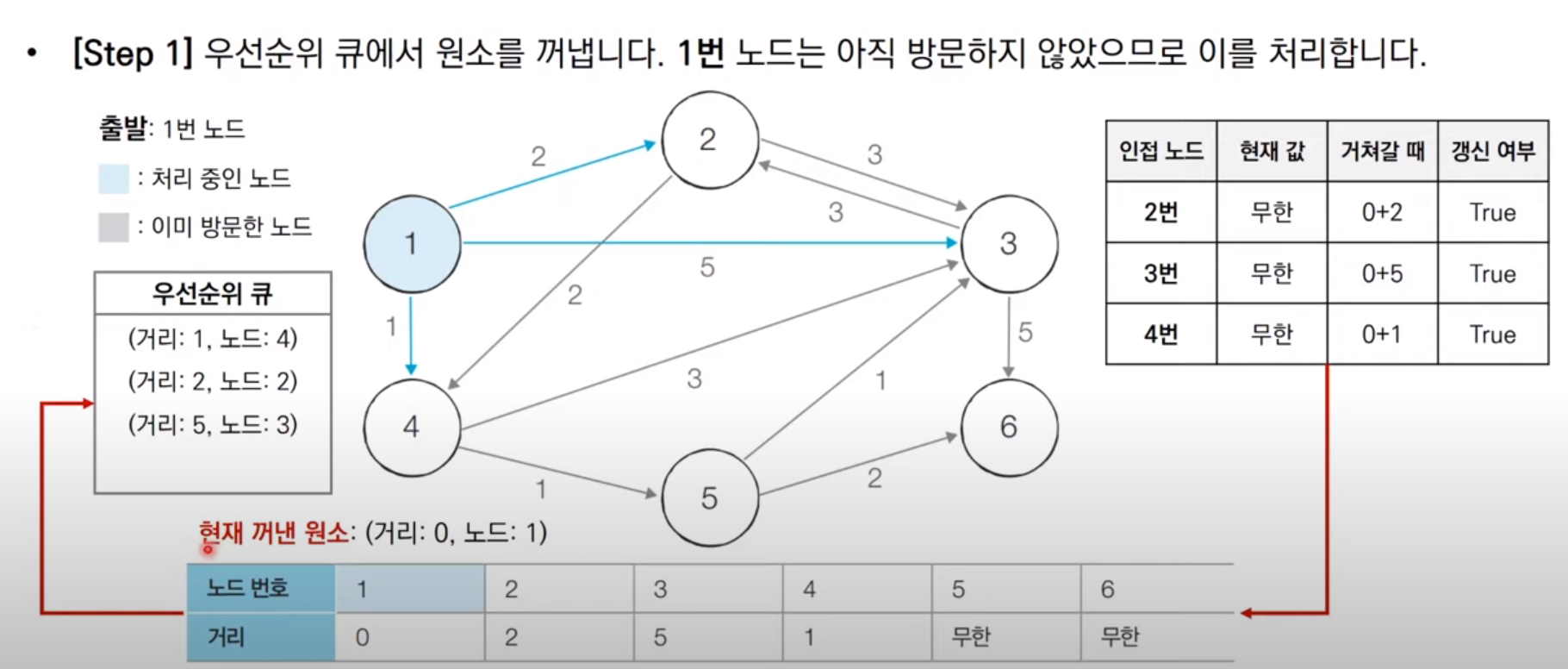
-
Step 2
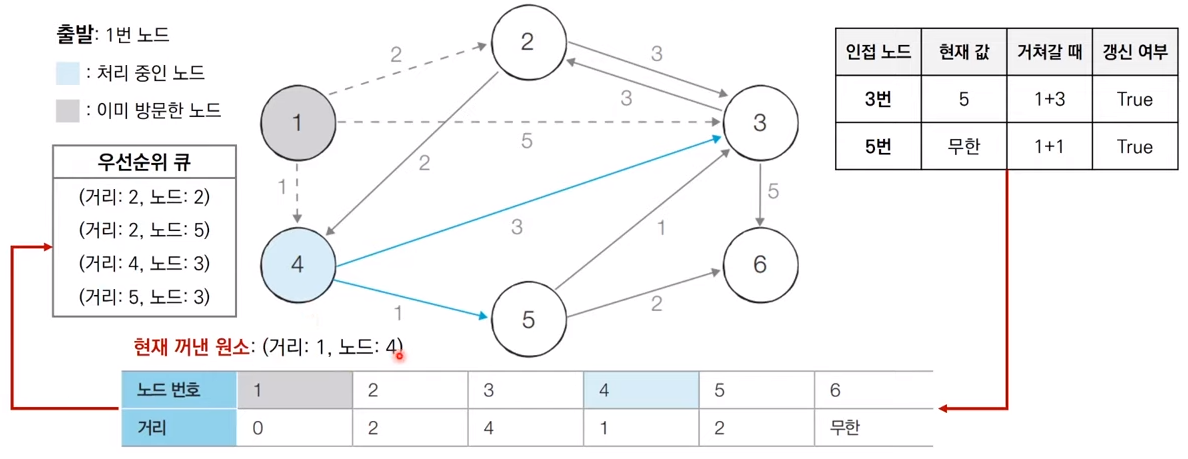
-
Step 3
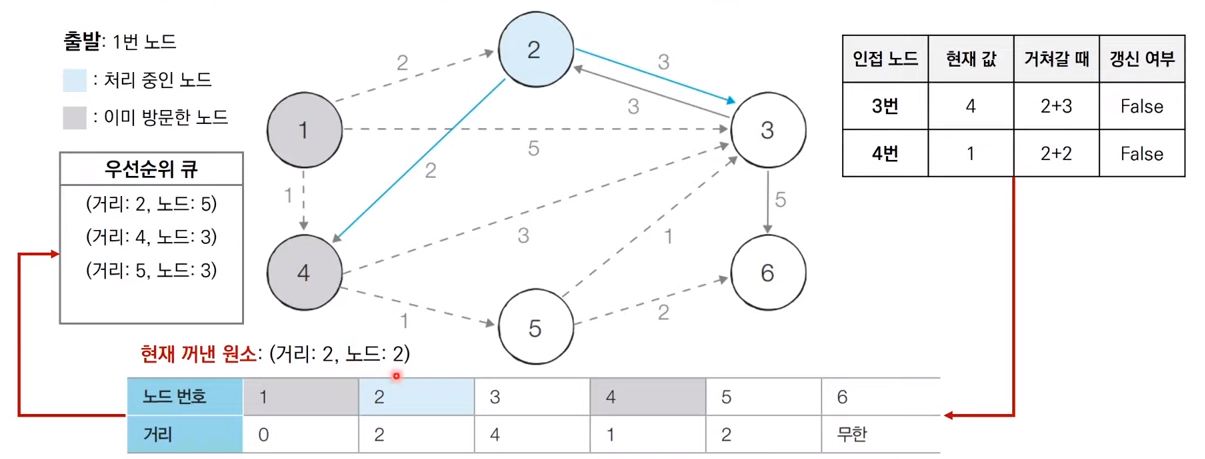
-
Step 4
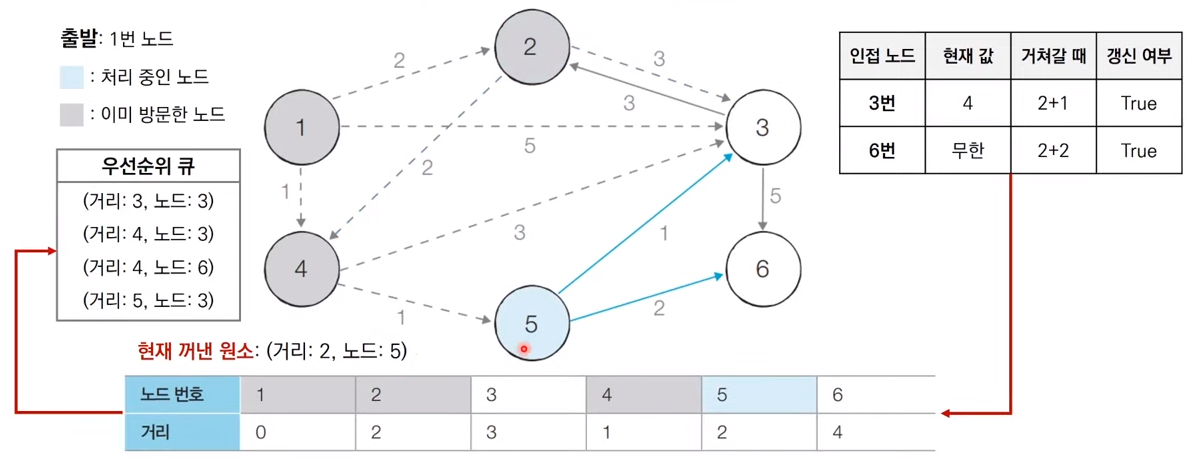
-
Step 5
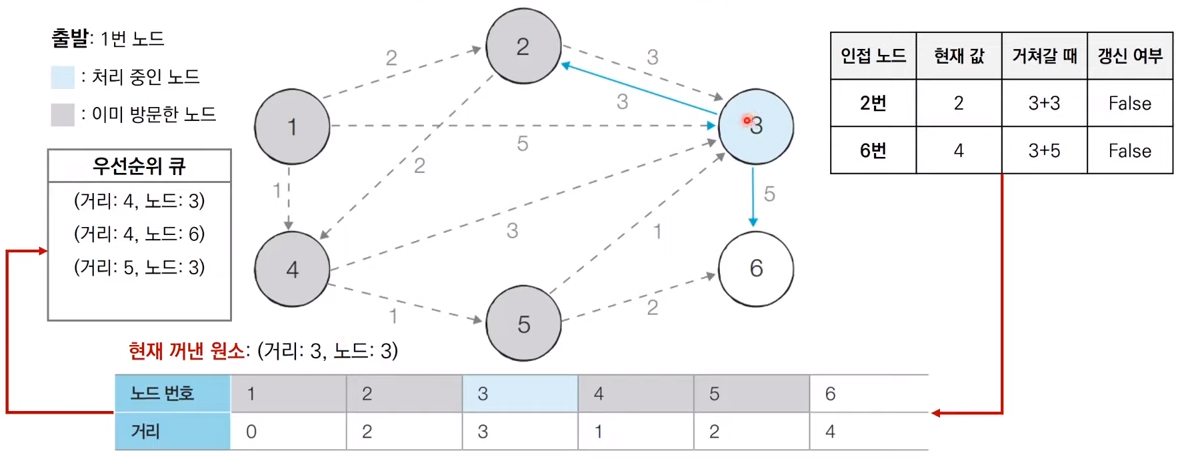
-
Step 6

-
Step 7
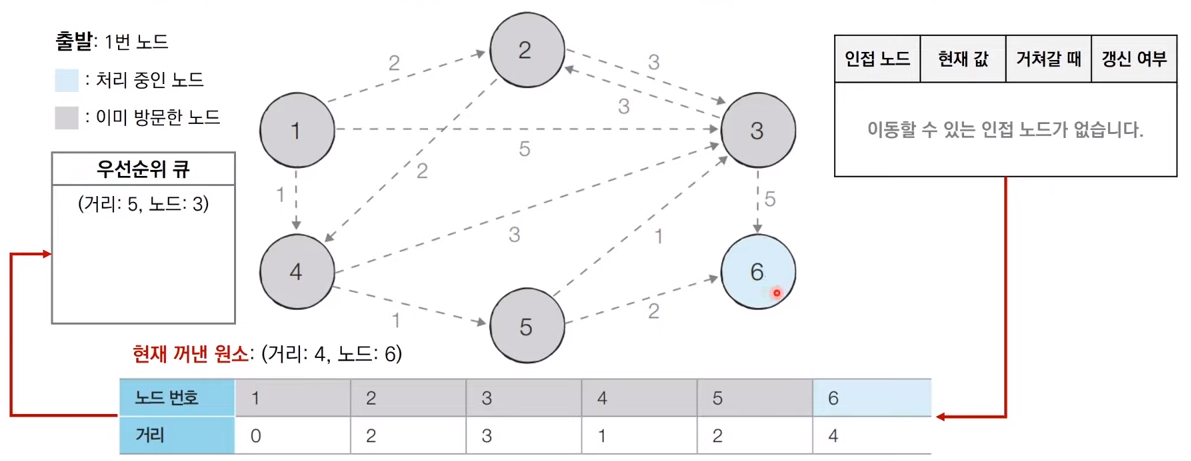
-
Step 8

구현 2
import java.io.BufferedReader;
import java.io.IOException;
import java.io.InputStreamReader;
import java.util.*;
class Node1 implements Comparable<Node1>{
private int index;
private int distance;
public Node1(int index, int distance){
this.index = index;
this.distance = distance;
}
public int getIndex(){
return this.index;
}
public int getDistance(){
return this.distance;
}
//거리가 짧은 것이 높은 우선 순위를 가지도록
@Override
public int compareTo(Node1 other){
if(this.distance < other.distance){
return -1;
}
return 1;
}
}
public class Dijkstra2 {
public static final int INF = (int) 1e9; //무한을 의미하는 값, 10억 설정
//노드의 개수 n. 간선의 개수 m . 시작 노드 번호 start
//노드의 개수는 최대 100,000
public static int n,m,start;
//각 노드에 연결되어 있는 노드에 대한 정보를 담는 배열
public static ArrayList<ArrayList<Node1>> graph = new ArrayList<>();
//최단 거리 테이블
public static int[] d = new int[100001];
public static void dijkstra(int start){
PriorityQueue<Node1> pq = new PriorityQueue<>();
//시작 노드로 가기 위한 최단 경로는 0으로 설정, 큐에 삽입
pq.offer(new Node1(start,0));
d[start] = 0;
while(!pq.isEmpty()){
//가장 최단 거리가 짧은 노드에 대한 정보 꺼내기
Node1 node = pq.poll();
int dist = node.getDistance();//현재 노드까지의 비용
int now = node.getIndex();// 현재 노드
//혀내 노드가 이미 처리된 적 있는 노드면 무시
if(d[now]<dist){
continue;
}
//현재 노드와 연결된 다른 인접한 노드들을 확인
for(int i=0;i<graph.get(now).size();i++){
int cost = d[now]+graph.get(now).get(i).getDistance();
//현재 노드를 거쳐서, 다른 노드로 이동하는 거리가 더 짧은 경우
if(cost<d[graph.get(now).get(i).getIndex()]){
d[graph.get(now).get(i).getIndex()] = cost;
pq.offer(new Node1(graph.get(now).get(i).getIndex(), cost));
}
}
}
}
public static void solution() throws IOException {
BufferedReader bf = new BufferedReader(new InputStreamReader(System.in));
StringTokenizer st = new StringTokenizer(bf.readLine());
int n = Integer.parseInt(st.nextToken());
int m = Integer.parseInt(st.nextToken());
int start = Integer.parseInt(st.nextToken());
///그래프 초기화
for(int i=0;i<=n;i++){
graph.add(new ArrayList<Node1>());
}
//모든 간선 정보 입력 받기
for(int i=0;i<m;i++){
st = new StringTokenizer(bf.readLine());
int a = Integer.parseInt(st.nextToken());
int b= Integer.parseInt(st.nextToken());
int c = Integer.parseInt(st.nextToken());
// a번 노드에서 b번 노드로 가는 비용이 c
graph.get(a).add((new Node1(b,c)));
}
//최단 거리 테이블을 모두 무한으로 초기화
Arrays.fill(d, INF);
//다익스트라 알고리즘 수행
dijkstra(start);
//모든 노드로 가기 위한 최단 거리 출력
for(int i=1;i<n;i++){
//도달할 수 없는 경우
if(d[i]==INF){
System.out.println(INF);
}
//도달할 수 있는 경우 거리 출력
else{
System.out.println(d[i]);
}
}
}
}
성능 분석
- 힙 자료구조 이용 시 시간복잡도 : O(ElogV)
- 노드를 하나씩 꺼내 검사하는 반복문(while)은 노드의 개수 V 이상으로 처리되지 않음
- 결과적으로 현재 우선순위 큐에서 꺼낸 노드와 연결된 다른 노드를 확인하는 총횟수는 최대 간선의 개수 E만큼 연산이 수행 - 직관적으로 전체 과정은 E개의 원소를 우선순위 큐에 넣었다가 모두 빼내는 연산과 매우 유사
- 시간 복잡도를 O(ElogE)로 판단
- 중복 간선을 포함하지 않는 경우에 이를 O(ElogV)로 정리할 수 있다.
- O(ElogE) ->O(ElogV^2)->O(2ElogV)->O(ElogV)
